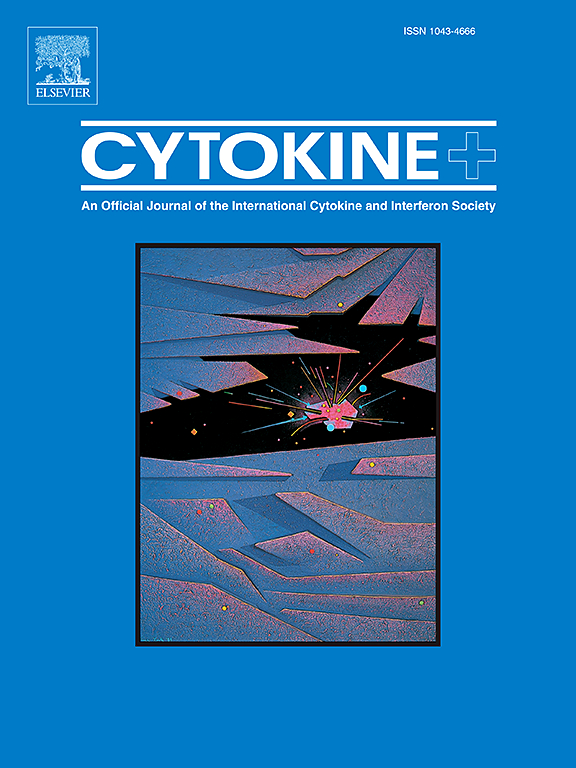骨髓上清S100A8、S100A9对骨髓增生异常肿瘤的诊断价值及临床相关性
IF 3.7
3区 医学
Q2 BIOCHEMISTRY & MOLECULAR BIOLOGY
引用次数: 0
摘要
目的:骨髓增生异常肿瘤(MDS)是起源于骨髓(BM)造血干细胞的异质肿瘤。S100A8和S100A9 (S100A8/9)是参与MDS先天免疫发病的关键分子。本研究旨在探讨这些分子在MDS鉴别诊断中的价值,并分析其浓度与临床特征的相关性。方法:采用酶联免疫吸附法(ELISA)检测80例MDS和26例再生障碍性贫血患者骨髓上清中S100A8/9的浓度。结合患者临床资料,探讨临床特征与S100A8/9的相关性。结果:我们的研究发现MDS患者BM上清液中S100A8/9浓度显著高于AA患者(P均为0.05)。结论:BM上清液中S100A8/9的浓度对MDS和AA的鉴别诊断有潜在价值。分子浓度与临床特征的相关性为MDS的进一步研究提供了新的视角。本文章由计算机程序翻译,如有差异,请以英文原文为准。
The diagnostic value and clinical correlations of bone marrow supernatant S100A8 and S100A9 in myelodysplastic neoplasms
Purpose
Myelodysplastic neoplasms (MDS) are heterogeneous neoplasms that originate from bone marrow (BM) hematopoietic stem cells. S100A8 and S100A9 (S100A8/9) are crucial molecules involved in the innate immune pathogenesis of MDS. This study aimed to explore the value of these molecules in the differential diagnosis of MDS, and analyze the correlations between their concentrations and clinical characteristics.
Methods
We measured the concentrations of S100A8/9 in BM supernatant from patients newly diagnosed with MDS (n = 80) or aplastic anemia (AA) (n = 26) by enzyme-linked immunosorbent assay (ELISA). Correlations between clinical characteristics and S100A8/9 were explored based on patients' clinical information.
Results
Our study found the concentrations of S100A8/9 in the BM supernatant of MDS patients were significantly higher than those in AA patients (Both P < 0.05). The concentrations of S100A8/9 in the group of very low/low/partial intermediate (IPSS-R score ≤ 3.5) risk MDS patients were also higher than those in AA patients (Both P < 0.05). The serial or parallel diagnostic tests combining these two molecules for differentiating IPSS-R score ≤ 3.5 MDS and AA yielded high positive or negative predictive values, respectively. Moreover, the concentrations of S100A8/9 in MDS patients were positively correlated with the patients' age and the proportion of granulocytic series in BM (All P < 0.05). Meanwhile, the concentrations of the two molecules had significantly negative correlations with the proportion of erythrocytic series in BM (Both P < 0.05). However, intergroup differences in concentrations of S100A8/9 were not significant among different MDS risk groups, whether by IPSS-R or IPSS-M (All P > 0.05).
Conclusion
The concentrations of S100A8/9 in BM supernatant have potential value in the differential diagnosis of MDS and AA. The correlations between the molecules' concentrations and clinical characteristics could provide new perspectives for future research in MDS.
求助全文
通过发布文献求助,成功后即可免费获取论文全文。
去求助
来源期刊

Cytokine
医学-免疫学
CiteScore
7.60
自引率
2.60%
发文量
262
审稿时长
48 days
期刊介绍:
The journal Cytokine has an open access mirror journal Cytokine: X, sharing the same aims and scope, editorial team, submission system and rigorous peer review.
* Devoted exclusively to the study of the molecular biology, genetics, biochemistry, immunology, genome-wide association studies, pathobiology, diagnostic and clinical applications of all known interleukins, hematopoietic factors, growth factors, cytotoxins, interferons, new cytokines, and chemokines, Cytokine provides comprehensive coverage of cytokines and their mechanisms of actions, 12 times a year by publishing original high quality refereed scientific papers from prominent investigators in both the academic and industrial sectors.
We will publish 3 major types of manuscripts:
1) Original manuscripts describing research results.
2) Basic and clinical reviews describing cytokine actions and regulation.
3) Short commentaries/perspectives on recently published aspects of cytokines, pathogenesis and clinical results.
 求助内容:
求助内容: 应助结果提醒方式:
应助结果提醒方式:


